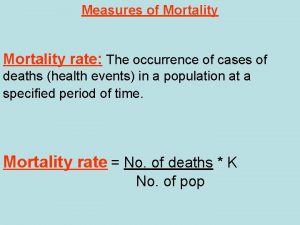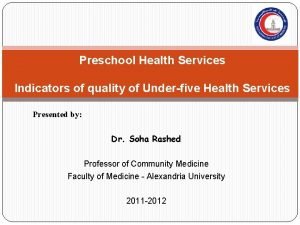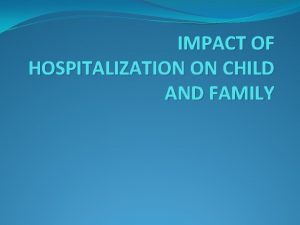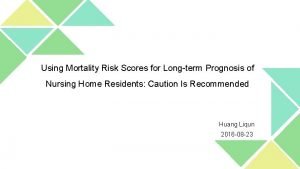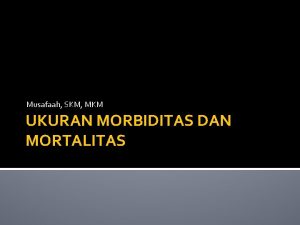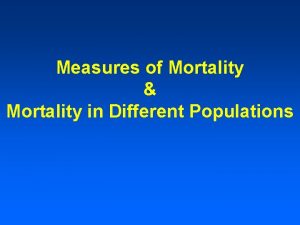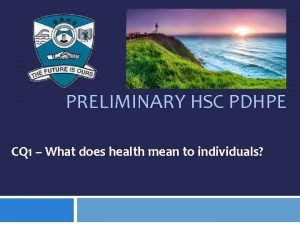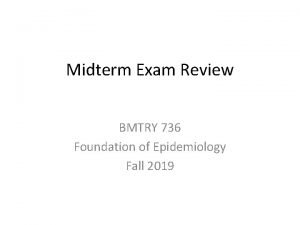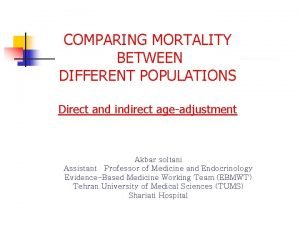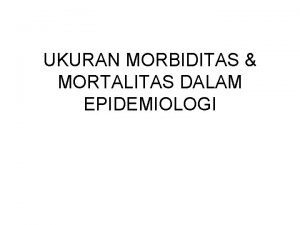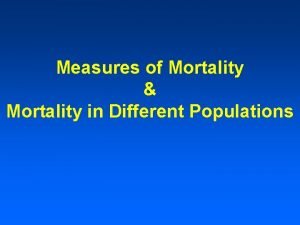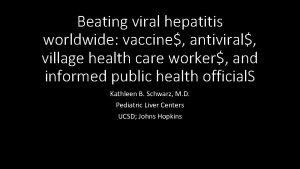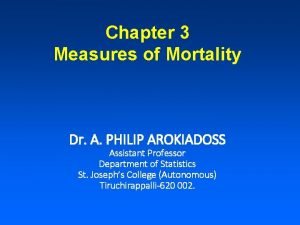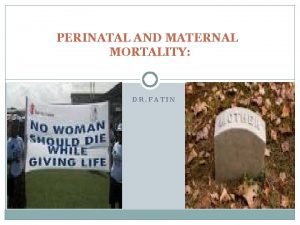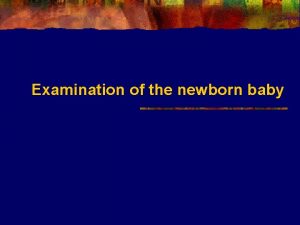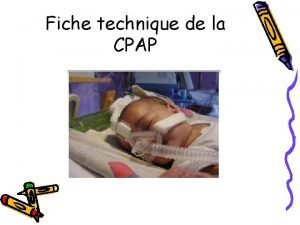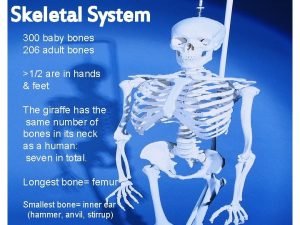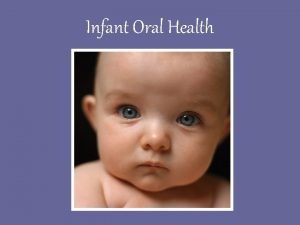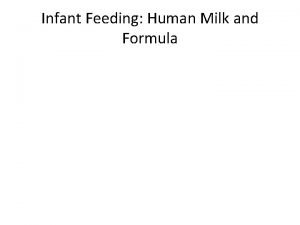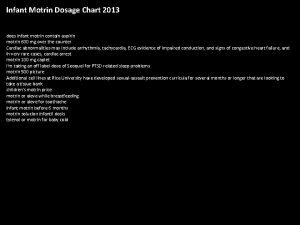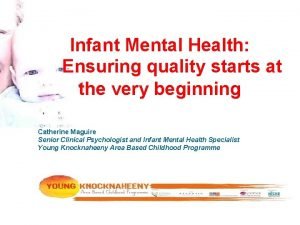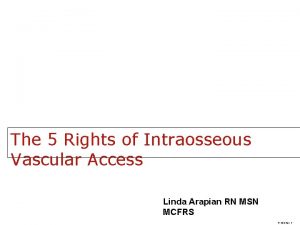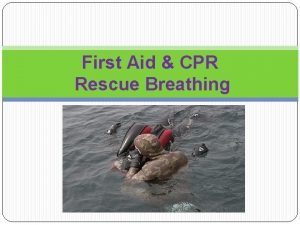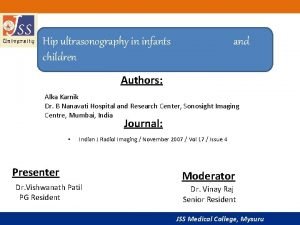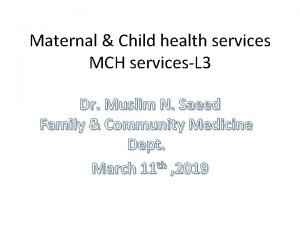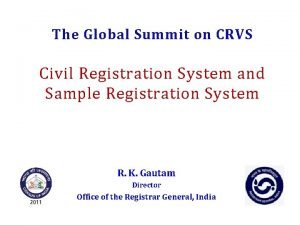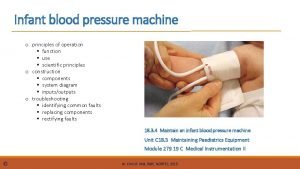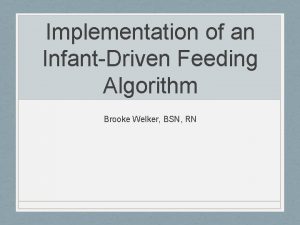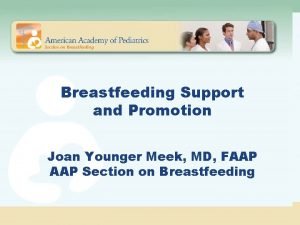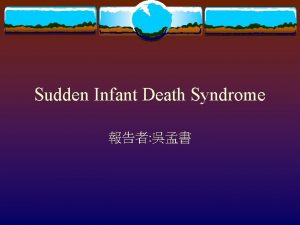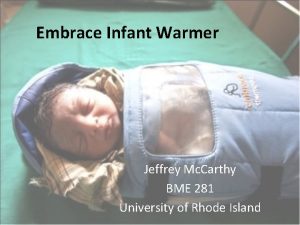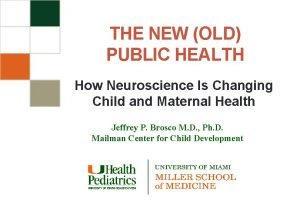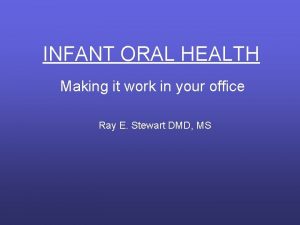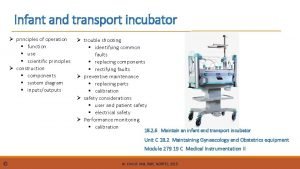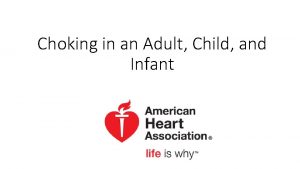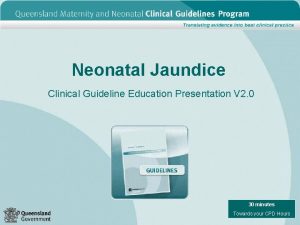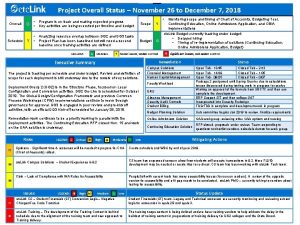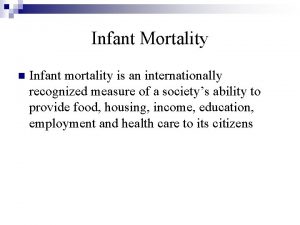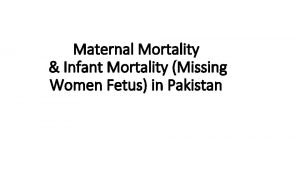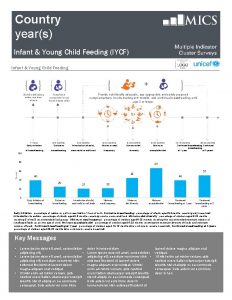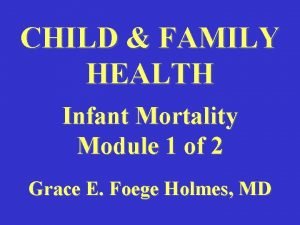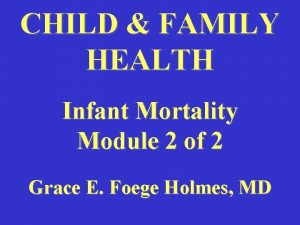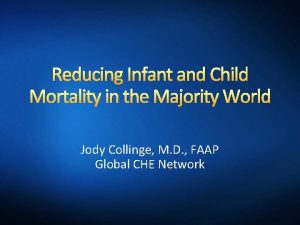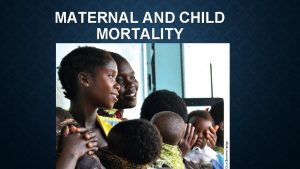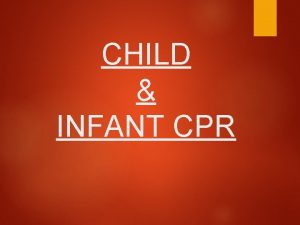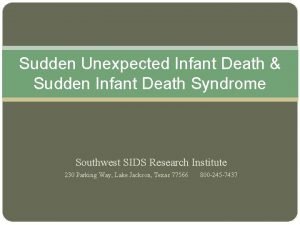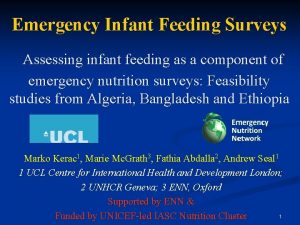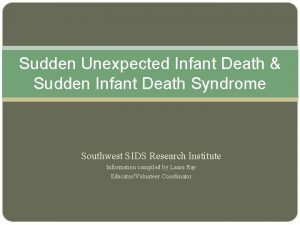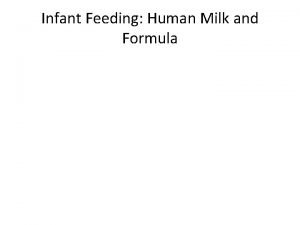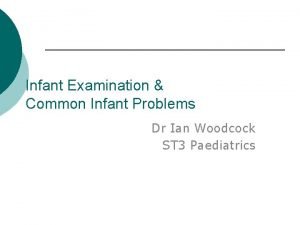Infant Mortality Impact on overall Child Mortality in






















































![Results “[The FIMR program] …also creates a setting and a set of concrete activities Results “[The FIMR program] …also creates a setting and a set of concrete activities](https://slidetodoc.com/presentation_image_h/2c064f67ea818ec63084ec7f03da592a/image-55.jpg)





















































- Slides: 108

Infant Mortality – Impact on overall Child Mortality in Kansas Effective Strategies to reduce infant mortality July 17, 2009



Presentation Goals: 1. Describe the impact of fetal and infant deaths on the overall child mortality rate for the US and Kansas 2. Identify the risk factors contributing to infant deaths due to conditions originating in the perinatal period. 3. Conduct effective reviews of infant deaths using lessons learned from FIMR

Infant Mortality • Definition: The death of any live born infant prior to his/her first birthday. • “The most sensitive index we possess of social welfare. . . ” Julia Lathrop, Children’s Bureau, 1913

Definition of Live Birth ‘‘Live Birth’’ means the complete expulsion or extraction from its mother of a product of human conception, irrespective of the duration of pregnancy, which, after such expulsion or extraction, breathes, or shows any other evidence of life such as beating of the heart, pulsation of the umbilical cord, or definite movement of voluntary muscles, whether or not the umbilical cord has been cut or the placenta is attached. Source: K. S. A. 1995 Supplement 65 -2401, subsection (2), amended and effective July 1, 1995.

Definition of Fetal Death ‘‘Stillbirth’’ means any complete expulsion or extraction from its mother of a product of human conception the weight of which is in excess of 350 grams, irrespective of the duration of the pregnancy, resulting in other than a live birth as defined in this act and which is not an induced termination of pregnancy. Source: K. S. A. 1995 Supplement 65 -2401, subsection (3), amended and effective July 1, 1995.

Recommended Reporting of Fetal Deaths The 1992 Revision of the Model State Vital Statistics Act and Regulations recommends: ‘‘Each fetal death of 350 grams or more, or if weight is unknown, of 20 completed weeks gestation or more, calculated from the date last normal menstrual period began to the date of delivery, is reported to the office of Vital Records.

Variation in Fetal Death Reporting across States – Eleven areas report all periods of gestation – 25 areas report gestation periods of 20 weeks or more – 13 areas specify birth weight of 350 grams or more or 20 weeks of gestation or more; – 1 area specifies 20 weeks or more or birth weight of 400 grams – 1 area specifies 20 weeks or more or birth weight of 500 grams – 1 area specifies 16 weeks of gestation or more – 1 area specifies 5 months of gestation or more.

Additional Definitions • Perinatal Death – Fetal deaths (stillbirths) plus infant deaths under 7 days • Neonatal Death – Live birth dying within 28 days • Post-Neonatal Death – Live birth dying between 28 days and 1 year Source: National Center for Health Statistics, CDC

Deaths per 1000 live births US Infant Mortality Rate

US Infant Death Rates 1995 - 2006 = 28, 527 infant deaths

US Fetal Death Rates 1995 - 2005, 25, 894 Fetal Deaths

Maternal Mortality • • • 569 Maternal Deaths in the US in 2006 Rate = 13. 3/100, 000 live births White Rate = 9. 5/100, 000 Hispanic Rate = 10. 5/100, 000 Black Rate = 32. 7/100, 000 Disparity Ratio for Black to White of 3. 5/1

Total US Deaths of Children ages 0 – 19 years 53, 501 Child deaths in 2005, 0 – 19 years 28, 440 or 53% are infant under 1

Kansas: Percent of Child Deaths by age at Death In 2005, 547 Child Deaths 0 – 19. 294, or 54% were Infants under one

Infant mortality rates by maternal race/ethnicity US, 1996 -2005 All race categories exclude Hispanics. An infant death occurs within the first year of life. Source: National Center for Health Statistics, period linked birth/infant death data. Retrieved April 8, 2009, from www. marchofdimes. com/peristats.

Infant mortality rates by maternal race/ethnicity US, 2005 All race categories exclude Hispanics. An infant death occurs within the first year of life. Source: National Center for Health Statistics, period linked birth/infant death data. Retrieved April 8, 2009, from www. marchofdimes. com/peristats.

Neonatal and postneonatal mortality rates US, 1960 -2005 A neonatal death occurs in the first 28 days of life. A postneonatal death occurs between 28 days and one year of life. Source: National Center for Health Statistics, period linked birth/infant death data. Retrieved April 8, 2009, from www. marchofdimes. com/peristats.

Preterm births among singleton deliveries US, 2006 Preterm is less than 37 completed weeks gestation. Source: National Center for Health Statistics, final natality data. Retrieved April 8, 2009, from www. marchofdimes. com/peristats.

State Rankings for Overall Infant Mortality • • Mississippi (11. 3) Louisiana (10. 1) South Carolina (9. 4) Alabama (9. 4) Delaware (9. 0) Tennessee (8. 9) North Carolina (8. 8) Ohio (8. 3) • • Georgia (8. 2) Oklahoma (8. 1) West Virginia (8. 1) Indiana (8. 0) Arkansas (7. 9) Michigan (7. 9) Missouri (7. 5) Virginia (7. 5) ¬Kansas (7. 4) Source: National Kids Count Database

Deaths per 1000 live births Kansas Infant Mortality: Black and White Source: 1995 -2007 The Kansas Department of Health and Environment Vital Records

Kansas’ Disparity Ratio B/W ratio 2. 8 Source: 1995 -2007 The Kansas Department of Health and Environment Vital Records

Kansas Ranks 47 th among States for Black Infant Mortality Rate Source: National Center for VS, CDC States: Black IMR 05 Rank: Delaware 18. 9 50 Michigan 18. 3 49 Wisconsin 17. 7 48 Kansas 17. 6 47 Mississippi 17. 2 46 DC* 17 Indiana 17 45 Ohio 16. 9 44 North Carolina 16. 4 43 Illinois 16. 4 43 Colorado 16. 3 41 USA 13. 7

Percent of all Kansas Births by Race, 2007 • • • Total births: 41, 951 White births: 30, 170 (72%) Black births: 2, 856 (6. 8%) Hispanic Moms, all races: 6, 676 (15. 9%) Other/Multiple races, non-hispanic: 5. 3% Source: 1995 -2007 The Kansas Department of Health and Environment Vital Records

Percent of Births by Race and Ethnicity US Compared to Kansas

Deaths per 1000 live births Kansas Infant Mortality trend Rates by Race & Ancestry Source: 1995 -2007 The Kansas Department of Health and Environment Vital Records

Leading Causes of Infant Death (2007) from Death Certificates 62% Source: 1995 -2007 The Kansas Department of Health and Environment Vital Records

Preterm and Low Birth Weight in Kansas Percent of all Live Births Preterm 1995 2005 2010 US Objective 9. 9% 12. 2% 7. 6% 7. 2% 5. 0% Low Birth 6. 4% Weight Source: March of Dimes, Peristats http: //www. marchofdimes. com/peristats/

Infant Mortality Racism Fatherless households Limited Poverty Access to Care Weathering Bad Housing Under. Education Bad Neighborhoods Unemployment Premature Birth Hopelessness Stress Low Birth Weight Smoking Substance Use Family Support Poor Working Conditions Genetics Nutrition With permission from Arthur James, MD

When Vital Statistics alone cannot tell us the story. . . . Communities turn to FIMR to tell us how and why babies are dying

Addison and Aiden were the most popular names given to newborns by Kansas parents in 2008. Source: 1996 -2009 The Kansas Department of Health and Environment

Fetal Infant Mortality Review 1988 - 2009 • A process that tells us How and Why babies die in a community

National Fetal and Infant Mortality Review (NFIMR) NFIMR is a Collaborative Effort between the: • American College of Obstetricians and Gynecologists (ACOG) • Federal Maternal and Child Health Bureau, Health Resources and Services Administration (MCHB, HRSA)

FIMR 1988

FIMR Today Over 240 projects in 42 states

Characteristics of State FIMR Programs • Over 240 Local FIMR projects in 42 States • 25 States have a State Coordinator with training and technical assistance available • Most FIMR’s are administered through local public health

The FIMR Process • FIMR brings a multidisciplinary community team together to examine confidential, deidentified cases of infant deaths. Review Team

FIMR: Two Tiered Process CRT Case Review Team CAT Community Action Team

Selected Components of FIMR

Confidentiality • FIMR cases are deidentified so that the names of families, providers and institutions are confidential – the FIMR focus is on improving systems, NOT assigning blame.

FIMR Focuses on Systems v Each FIMR case review provides an opportunity to improve communication among medical, public health and human service providers and develop strategies to improve services and resources for women, children and families.

“The process that brings together people to learn from the story of a family that experienced a fetal or infant loss helps awaken both commitment and creativity. The stories illustrate community needs that are concrete, local and significant. The interaction among diverse community participants generates ideas for action that might lie beyond the imagination and power of an individual provider or agency. ” Seth Foldy, MD Former Commissioner of Health, Milwaukee WI

FIMR Includes a Family Perspective Home Interview • Gives insight into the mother’s experience before and during pregnancy • Conveys the mother’s story of her encounters with local service systems

“Maternal interviews give a voice to the disenfranchised in my community, those without clout or power. FIMR provides a rare opportunity for the ‘providers’ in a community to hear from the consumers. ” Patt Young, FIMR Interviewer, Alameda/Contra Costa Counties, CA

FIMR Promotes Broad Community Participation • FIMR is a community coalition that can represent all ethnic and cultural community views and becomes a model of respect and understanding.

“The Growing Into Life FIMR Task Force…has built respect and friendship among races, between classes, around language, and among those of differing political and economic interests. ” Karen Papouchoado, Former Mayor Aiken, SC

FIMR is Action-Oriented. FIMR leads to multiple creative community actions to improve resources and service systems for women, infants and families.

FIMR’s Strength • Access to medical records • Home Interviews (Qualitative Data) • Community specific determinants of Infant Mortality

Use of Data • Death certificates provide an overview of all infant deaths • When matched with birth certificates, we know maternal characteristics, prenatal care, and labor complications • FIMR provides information on more specific psychosocial issues, gaps in care, factors which contribute to infant death in specific communities

Evaluation of FIMR Programs Nationwide

Methods • 193 participating communities • Cross-sectional observational study (Telephone interview, written survey & site visits) – Communities with FIMR – Communities with Perinatal Initiative – Communities with both (FIMR & PI) – Communities with neither

Results FIMR Programs contribute significantly to improvements in systems of health care for pregnant women and infants through enhanced public health activities in Communities.

FIMR-Specific Influences • • • Data assessment and analysis Client services and access Quality improvement for systems of care Partnerships and collaboration Population advocacy and policy development
![Results The FIMR program also creates a setting and a set of concrete activities Results “[The FIMR program] …also creates a setting and a set of concrete activities](https://slidetodoc.com/presentation_image_h/2c064f67ea818ec63084ec7f03da592a/image-55.jpg)
Results “[The FIMR program] …also creates a setting and a set of concrete activities wherein everyone has a contribution to make and everyone learns from the process. The case study findings indicate that because the FIMR process extends beyond problem identification to promote problem solutions, observable changes in practice and programs occur; ‘things get fixed’ and participants are inspired to take further action. ” • Source: Women's and Children's Health Policy Center, Johns Hopkins University. The evaluation of FIMR programs nationwide: early findings. [Online, 2002]. Available from: http: //www. jhsph. edu/wchpc/pub/Brochure. pdf.

FIMR as part of other MCH Initiatives – Vital Statistics – PRAMS (Pregnancy Risk Assessment Monitoring) – PPOR (Perinatal Periods of Risk) – CDR (Child Death Review) – MMMS (Maternal Mortality Surviellance) – BRFSS (Behavioral Risk Factor survey System)

Interaction of State Public Health and Local FIMR Projects • Technical Assistance • Grant of Authority/Legislation • Data Management

Technical Assistance • Hands on Training: – – – Team development Recruiting members for review and action teams Case Abstraction Access to Medical records Home Interviews/Bereavement • On site consultation for CRT and CAT – Connect sites with “best practices” and solutions from other communities – Assist teams with developing recommendations – Fidelity to Program: confidentiality, forms, etc.

Technical Assistance • Monthly Network Meeting – Dialog and common understanding of issues related to infant mortality and the FIMR process – in-services on factors associated with infant morbidity/mortality and maternal health – Create and maintain a base of support for FIMR personnel • Annual Training

Grant of Authority/FIMR Legislation • The laws and regulations relevant to the process of fetal and infant mortality review are found primarily in state rather than local or federal laws. All states have laws that afford immunity to those participating in certain types of reviews. • Many states have other regulations that permit access to medical and vital statistics records for “investigations for the benefit of the health of the public”.

Michigan’s Grant of Authority • Michigan’s Public Health Code provides authorization for local FIMR project staff to collect protected health information from covered entities on MDCH’s behalf for the purpose of “public health investigation” (Surveillance) of fetal and infant deaths. • 45 CFR 164. 512 (b) 45 164. 501 of the Privacy Rule permits disclosure to “a public health authority that is authorized by law to collect or receive such information for the purpose of preventing or controlling disease, injury, or disability. . vital events such as births or deaths, and the conduct of public health surveillance”.

New York State Public Health Law § 206. 1(j) Commissioner; general powers and duties » 1. The commissioner shall: » (j) cause to be made such scientific studies and research, which have for their purpose the reduction of morbidity and mortality and the improvement of the quality of medical care through the conduction of medical audits within the state. In conducting such studies and research, the commissioner is authorized to receive reports on forms prepared by him and the furnishing of such information to the commissioner, or his authorized representatives, shall not subject any person, hospital, sanitarium, rest home, nursing home, or other person or agency furnishing such information to any action for damages or other relief.

New York State Public Health Law § 206. 1(j) Commissioner; general powers and duties (cont. ) » Such information when received by the commissioner, or his authorized representatives, shall be kept confidential and shall be used solely for the purposes of medical or scientific research or the improvement of the quality of medical care through the conduction of medical audits. Such information shall not be admissible as evidence in any action of any kind in any court or before any other tribunal, board, agency or person.

Texas FIMR Legislation • Enacted in September of 2007, amends chapter 674 of Health and Safety Code. • Creates a FIMR as a unit of local government • States who may establish a FIMR team • Prescriptive of membership • Authorizes disclosure of information to review teams (includes medical, social, mental health) • Gives teams immunity from subpoena and

FIMR and HIPAA • The National Fetal and Infant Mortality Review, in collaboration with the American College of Obstetricians and Gynecologists and Hogan and Hartson, LLP, developed "The Fetal and Infant Mortality Review Process: The HIPAA Privacy Regulations. " This detailed monograph on FIMR and HIPAA is designed to help local and state FIMR programs understand the regulations. A PDF document is available at the NFIMR website: www. acog. org

Data Management • Administers and manages Statewide database for local FIMR’s – TA – Data analysis on request – Aggregate Annual Report • Examples of Database – Web Based: BASINET (created by Florida HS) – NFIMR: ACCESS database, free to states

FIMR and CDR common goal: Local, multidisciplinary review aids in better understanding how to prevent future deaths and improve lives of babies, children, and families.

Review preventable deaths Review mostly child abuse deaths Transitioning to prevention No review team(s) • CDR is now mandated or enabled by law in 39 states. • 22 are housed out of their State Health Department. • 37 states now have local review teams. • 48 states review deaths through age 17. • Half review deaths to all causes. • Median state funding level is $150, 000, with limited local funding

Case Inclusion Criteria FIMR • Reviews deaths of infants born live who do not reach their first birthday • Select cases of fetal death (<400 grams or 20 weeks gestation) • • • CDR Age of child < 18 All unexplained deaths All fatal abuse and neglect deaths All homicides and suicides All accidents/injuries

Effective Reviews of Perinatal/Neonatal Deaths • Get the right People to the table. . . • Gather enough data to give a clear picture of maternal health history • Identify the risks, gaps in care and services • Put findings into action to improve care and resources for women, infants, and families

Team Composition FIMR • Medical Expertise – – – CDR OB • Law enforcement Peds • Prosecutors Pathology • Social Services/FIA ED Family Practice

Team Composition CDR FIMR • Other Health Care Providers • Emergency Medical Personnel – Nurses – Social Workers • Medical Examiners – Dietitian – Discharge Planning – Home Care

Team Composition FIMR CDR • Human Service Providers • Department of Corrections • Housing Authority • Transportation Authority – Child Welfare Agencies – Mental Health – Substance Abuse

Team Composition FIMR • Public Health – – – Medicaid WIC Family Planning MSS/ISS Outreach Workers CDR • Schools District • Juvenile Court • Child Care Licensing

Team Composition FIMR/CDR • Community Leaders – Mayor, City Council, County Executive – Business Leaders, Chamber of Commerce – Clergy – Civic Groups (Kiwanis, Junior League)

Team Composition FIMR CDR • SIDS/OID Programs • Advocacy Groups • State and Local Safe Kids Coalitions – March of Dimes – Healthy Mothers/Healthy Babies – Family Support Groups

Effective Reviews of Perinatal/Neonatal Deaths • Get the right People to the table. . . • Gather enough data to give a clear picture of maternal health history • Identify the risks, gaps in care and services • Put findings into action to improve care and resources for women, infants, and families

Sources of information for Maternal Health History • Birth and Death certificates • Prenatal records – OB/GYN history, past pregnancies • Hospital records – Antepartum – Delivery – Newborn/NICU – ED admissions

Sources of information for Maternal Health History • Public Health Records – – MSS/ISS (Maternal Infant Health Program: MIHP) WIC Family Planning Other support services (CSHC, Healthy Start) • Human Service Records (including Child Protective Service histories) • Police reports (domestic violence, other stressors)

Risk Factors in Infant Deaths Maternal Characteristics • • • Living in poverty Unmarried Low education level Unintended, unwanted pregnancy Less than adequate prenatal care Smoking during pregnancy

Risk Factors cont. • • • Young maternal age (under 20) First birth as teen Victim of domestic violence Substance abuse during pregnancy Presence of life stresses – homelessness – lack of transportation – mental illness – poor nutrition

Effective Reviews of Perinatal/Neonatal Deaths • Get the right People to the table. . . • Gather enough data to give a clear picture of maternal health history • Put findings into action to improve care and resources for women, infants, and families • Identify the risks, gaps in care and services

Snapshots of Michigan FIMR’s. . . Translation of Findings into Action

Oakland County • Started FIMR in 2000 • One of the highest disparity ratio’s for Black/White Infant Mortality in the state: Black Rate = 25. 2, White Rate = 4. 3 Ratio 5. 9/1 • Team focused on reviewing deaths of all live born infants for residents of Pontiac and Southfield

FIMR in Oakland County, Michigan • population 1, 214, 255 • GM & Chrysler are top 2 employers • ranks 20 th nationally in total disposable income • City of Pontiac has 66, 337 residents, 5% of the county total • 48% of Pontiac residents are Black Oakland County

FIMR Findings: Factors most frequently contributing to Infant Mortality • • Low Birth weight Prematurity Sexually transmitted & other infections Frequent and closely spaced pregnancies Previous fetal or infant loss, termination Use of alcohol, tobacco, & other drugs Through home interview, women did not understand or recognize preterm labor signs

FIMR CAT Activities • Partnered with Faith Based Organizations • “Save our Babies, Save our Heritage” • A public awareness campaign to reduce heath disparities and infant deaths in Oakland County Material – Church Bulletin Inserts – Posters – Presentations to Parish Nurse Groups – Presentations to area churches in Pontiac and Southfield

Save Our Babies Save Our Heritage Brochure

Oakland County Infant Mortality Rates 1990 - 2005

Saginaw County • Population 210, 000 • City: 70, 000 • 28% Of County population is Minority • 58% of Saginaw City is Minority • Urban • Major Industries: – GM, Health Care, Education, Agriculture Saginaw

Saginaw FIMR Findings: Domestic Violence and Pregnancy • 20% of infant deaths reviewed have documented abuse • 31% of women report lifetime abuse • 5% of pregnant women are beaten while pregnant • Few prenatal care providers routinely asked women about abuse

Pregnancy and Abuse: Window of Opportunity • May be the only time a woman routinely seeks health care • Desire to protect baby • Opportunity to think about the future • Develops trust in provider

DV and Infant Loss P<0. 048

Domestic Violence and Pregnancy • Developed Screening and Assessment Tool – 5 questions – Every woman, every visit • Standard DV screening in all Prenatal Provider sites

Effects of DV Programs on Low Birth Weight Rate

Selected Risk Factors for 2004 FIMR Cases Reviewed Maternal Risk Number Percent First Pregnancy < 18 77 33. 5 < 12 th grade education 60 26. 1 Unplanned pregnancy 91 39. 6 Entry to care < 12 weeks 134 60. 9 Entry to care > 12 weeks 52 22. 6 Unknown ETC Total 44 230 19. 1 100

Plan First! • Through this waiver, MDCH offers family planning services to women: – 19 through 44 years of age. – Who are not currently Medicaid eligible. – Who do not have full family planning benefits through private insurance, including Medicare. – Who have family income at or below 185% of the federal poverty level (FPL).

SIDS or Something Else? • 12 - 15% of Infant Deaths in Michigan due to SIDS • Through FIMR and CDR, multiple communities began to identify that many of these deaths lacked one of the three criteria for SIDS diagnosis: – Negative Autopsy – Negative Death Scene Investigation – Negative Medical Health Hx

Large numbers of deaths were actually related to un- safe sleep environments. . .

Where Should Infant’s Sleep? A Comparison of Risk for Suffocation. . . Cribs vs. Adult Beds Scheers, Rutherford, & Kemp, Pediatrics, 2003

Translation to Action: SIDS/Asphyxia • Mandatory Death Scene Investigation using State of Michigan Protocol – State Police – Medical Examiners – Prosecutors • Enhanced education /public awareness on safe sleep environment

Michigan Legistation related to Safe Sleep and Suffocation: • House bill 5225 – became Public Act 179 on July 1, 2004 • Mandates investigation by county medical examiner for cases of child death (under 2) under circumstances of sudden death, cause unknown. • Promotes consistency and accuracy among county medical examiners in determining the cause of death

State Wide Prevention Efforts • Multidisciplinary State level task force convened: MDCH’s Division of Family and Community Health • Uniform message and recommendations issued for: – Child Care providers – Health care professionals – General public

State Wide Prevention Efforts • On-line training for providers, clinics, MIHP staff MIHealth. org • Developed web site through DHS • http: //michigan. gov/safesleep

Postneonatal Death Rate Trends Michigan 1990 - 2007

There is much to be learned about the delivery of services even if the death was not thought to be preventable.

National Fetal and Infant Mortality Review (NFIMR) Since 1990, NFIMR has been a resource center working with states and communities to develop fetal and infant mortality review programs. For more information about FIMR, call (202) 863 -2587, e-mail us at NFIMR@acog. com, or visit us at http: //www. acog. org/goto/nfimr.

The FIMR State Support Program is funded by the Michigan Department of Community Health, Administered by the Michigan Public Health Institute Rosemary Fournier, RN, BSN State FIMR Program Coordinator MDCH: Washington Square Building 109 W. Michigan Lansing, MI 48913 Phone: (517) 335 -8416 e-mail: Fournierr 1@michigan. gov
 Ecumene definition ap human geography
Ecumene definition ap human geography Proportionate mortality rate formula
Proportionate mortality rate formula Infant mortality rate formula
Infant mortality rate formula Infant mortality rate formula
Infant mortality rate formula Infant mortality calculation
Infant mortality calculation Infants, children and adolescents 8th edition
Infants, children and adolescents 8th edition Impact of hospitalization on child and family
Impact of hospitalization on child and family 패자트리
패자트리 Morbidity and mortality
Morbidity and mortality Calculate relative risk
Calculate relative risk Flacker mortality score
Flacker mortality score Rumus angka kelahiran kasar
Rumus angka kelahiran kasar Death rate formula
Death rate formula Mortality definition pdhpe
Mortality definition pdhpe Continuous mortality investigation
Continuous mortality investigation The great gasby theme
The great gasby theme The cause-specific mortality rate from roller-skating was:
The cause-specific mortality rate from roller-skating was: Age adjusted mortality rate definition
Age adjusted mortality rate definition Mortality vs morbidity
Mortality vs morbidity Disease specific mortality rate formula
Disease specific mortality rate formula Death rate formula
Death rate formula Attributable mortality
Attributable mortality Age adjusted mortality rate
Age adjusted mortality rate Miracle and morality plays
Miracle and morality plays Perinatal mortality rate
Perinatal mortality rate Phoenix infant academy
Phoenix infant academy Femoral pulse infant
Femoral pulse infant Promoting infant health section 7-2
Promoting infant health section 7-2 Pulse check in unresponsive victim
Pulse check in unresponsive victim Infant flow driver
Infant flow driver Baby bones vs adult bones
Baby bones vs adult bones Juan soriano la niña muerta; the dead girl; dead infant
Juan soriano la niña muerta; the dead girl; dead infant Chest compression ratio in newborn
Chest compression ratio in newborn Infant
Infant Infant-industry argument
Infant-industry argument Isomil df
Isomil df Social impulses foster infant language
Social impulses foster infant language Pregnancy and infant cohort monitoring and evaluation
Pregnancy and infant cohort monitoring and evaluation Infant motrin coupon
Infant motrin coupon Catherine maguire infant mental health
Catherine maguire infant mental health Where was botulism first discovered
Where was botulism first discovered Infant age
Infant age Infant oral health care
Infant oral health care Kenmore park infant and nursery school
Kenmore park infant and nursery school Walter infant school
Walter infant school Dormers wells infant school
Dormers wells infant school Infant industries apush
Infant industries apush Saguaro infant care and preschool
Saguaro infant care and preschool Baby reflexes
Baby reflexes Infant reflexes chart
Infant reflexes chart Counter clockwise
Counter clockwise What is 90 degree angle for injection
What is 90 degree angle for injection Downs view infant school
Downs view infant school Infant/toddler sensory profile score sheet
Infant/toddler sensory profile score sheet Social impulses foster infant language
Social impulses foster infant language High quality cpr child
High quality cpr child Llf meaning cpr
Llf meaning cpr Personality development in infancy
Personality development in infancy Alpha and beta angle in ddh
Alpha and beta angle in ddh Primitive reflexes chart
Primitive reflexes chart Pallor cyanosis
Pallor cyanosis Infant death rate
Infant death rate Wood street infant school
Wood street infant school Hart plain infant school
Hart plain infant school Woodfield infant school
Woodfield infant school Woolston infant school
Woolston infant school Sparhawk infant school
Sparhawk infant school Pinewood infant school
Pinewood infant school Infant blood pressure
Infant blood pressure Keeping an infant safe and well section 7-3
Keeping an infant safe and well section 7-3 Nicu pain scale
Nicu pain scale For sale: baby shoes never worn
For sale: baby shoes never worn Brigance scoring
Brigance scoring Brooke welker
Brooke welker Convent of the holy infant jesus school
Convent of the holy infant jesus school Weight gain in infant
Weight gain in infant Governance
Governance What is habituation
What is habituation Infant development
Infant development Livedo mortis
Livedo mortis Infant industry
Infant industry Drdp modified essential view
Drdp modified essential view Denis browne bar
Denis browne bar Embrace infant warmer
Embrace infant warmer An infant's growth refers to changes in
An infant's growth refers to changes in Jama 2017
Jama 2017 Infant oral health care
Infant oral health care Infant incubator working principle
Infant incubator working principle Infant
Infant Pathologic jaundice newborn
Pathologic jaundice newborn Industry target market feasibility analysis example
Industry target market feasibility analysis example The overall reaction in a commercial heat pack
The overall reaction in a commercial heat pack Strategic planning in retailing
Strategic planning in retailing Overall teacher judgement
Overall teacher judgement A nation's overall plan for dealing
A nation's overall plan for dealing Theme of romeo and juliet
Theme of romeo and juliet Overall project status
Overall project status Charles maurice de talleyrand-périgord previous offices
Charles maurice de talleyrand-périgord previous offices What elements of design are stiff, rough, shiny and smooth?
What elements of design are stiff, rough, shiny and smooth? Which of the following is not part of overall biodiversity
Which of the following is not part of overall biodiversity Overall project status
Overall project status Literary elements tone
Literary elements tone Project overall status
Project overall status What are the net products of the krebs cycle
What are the net products of the krebs cycle Overall agenda
Overall agenda Overall scale
Overall scale Triangular pitch formula
Triangular pitch formula Overall reaction of glycolysis
Overall reaction of glycolysis Selecting an overall positioning strategy
Selecting an overall positioning strategy

